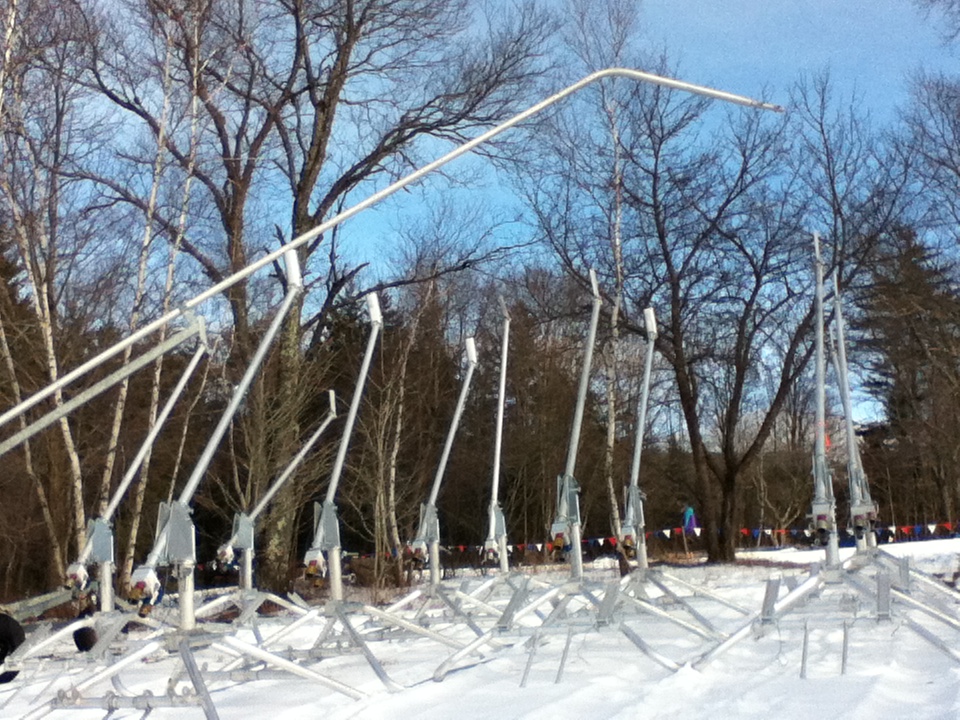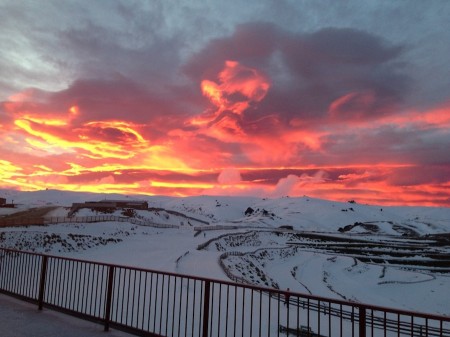
Welcome back to This Month in Journals! After taking the winter off to focus on race reporting, we’re doing a series to catch up on the ski-related research that has been published in scientific and social science journals this winter.
The Intergovernmental Panel of Climate Change (IPCC) recently came out with a new report, even more alarming than its previous ones. Besides noting that extreme weather events would increase and certainly have a huge impact on people around the world, the panel cited the need for adaptation.
“Responding to climate-related risks involves making decisions and taking actions in the face of continuing uncertainty about the extent of climate change and the severity of impacts in a changing world, with potential limits to the effectiveness of incremental approaches,” the panel wrote in their technical summary. “… Adaptation planning and implementation at a range of scales are contingent on values, objectives, and risk perceptions. Some types of adaptation options, such as insurance or large-scale infrastructure projects, may differentially affect stakeholders.”
What does this mean for the ski world? A variety of research groups published papers this winter looking at perceptions of climate change in the ski industry, both from tourists and other stakeholders, and whether they think adaptation is important. Here’s what they found.
* Drs. Mia Landauer, Wolfgang Haider, and Ulrike Pröbstl-Haider published a comparison of climate change perceptions in Austrian and Finnish cross country skiers in the Journal of Travel Research in January.
The authors identified three potential ways for ski areas to adapt to climate change: using technology such as snowmaking, snow saving, and ski tunnels; diversifying into activities that don’t depend on snow; and promoting all-season tourism rather than winter tourism. Then they examined how Finnish and Austrian skiers’ preferences for these strategies were affected by their cultural background.
And there were major differences between these cultural backgrounds. For instance, in Finland, skiing was a form of transportation for hundreds of years, trails are groomed free of charge, and citizens expect to be able to use public and private land for recreation, as one of their basic rights. Most skiers learn in their childhood. In general, the culture has been characterized by more long-term than short-term thinking.
In Austria, cross-country skiing is much more of a tourist product, and trails these days are more likely to be groomed by private businesses or individuals who charge for trail access. Skiers are more likely to have learned as adults. The authors identified masculinity and “avoidance of uncertainty” as general cultural traits in the country.
The authors found that about half the skiers in each country mainly hit the trails to enjoy nature and get outside. But in Finland, almost twice as many of the others ski for the sporting and fitness aspects of the activity and don’t mind skiing alone, while more Austrians consider it a social activity. 85% of the Finns skied more than 30 days in a winter; most Austrians went out just six to ten days.
What did this mean for climate adaptation? The Finns, with their emphasis on skiing as sport, were more interested in using technical advances such as snowmaking and building ski tunnels. The Austrians, who were more interested in seeing nature with their friends, were uninterested in ski tunnels. However, the Finns expected these infrastructure improvements to be paid in the interest of the public good, although they were somewhat willing to pay for access ski tunnels if the snow was good. Since Austrians already pay trail user fees, they were willing to do so for further improvements.
In terms of diversification, Finns were more interested in seeing resorts offer other non-snow and year-round sport activities, either indoors or outdoors. Because the Austrians were not as interested in skiing as an athletic or fitness activity, they had less strong preferences for this type of adaptation. Instead, they were more interested in seeing cultural programs and nature experiences being offered in the place of on-snow skiing.
The authors write that their study emphasizes how climate change must be addressed differently in different settings.

“Ignoring cultural differences would likely increase management problems, lead to conflicts, and also to a significant decrease in skiing participation,” they wrote in their conclusion. “[Our study] underlines the importance and necessity to consider social limits—such as culture—to adaptation to climate change.”
* Other work looked at the attitudes of not the skiers themselves, but those running the ski areas. Dr. Lisa Trawöger from the University of Innsbruck assessed the perception of tourism stakeholders in Austria about whether climate change was a threat to their winter tourism system.
In the journal Tourism Management, Dr. Trawöger began by reviewing previous work on stakeholder attitudes. She noted that ski resort operators in Switzerland have been cognizant of, and worried about, climate change since the early 2000’s: after all, they have seen its effects firsthand.
Attitudes of winter tourism businesspeople in the rest of Europe range from skeptical of climate change, to acknowledging its existence but worrying only about the bottom line. In many places, like northern Sweden, people weren’t sure whether climate change would affect tourism. In others, increased awareness of the problem had been noted in time spans as short as two years, perhaps because of low-snow winters in 2006 and 2007.
So, Dr. Trawöger turned to the Tyrol region of Austria. There, she found ski company CEO’s who had discussed climate change in their work but were highly skeptical of its effects, and who did not believe research which predicts that it will affect winter tourism their region.
“A few years ago they said we would have less snow,” a cable care company CEO told her. “We had a lot of snow and they told us it was an exception. We had five exceptions in a row. They also said it would get warmer and then we had a freezing cold winter. That doesn’t increase our confidence in studies. We can‘t estimate the long-term effects of climate change from the results we have received so far.”
Of 24 CEO’s interviewed, only five were actively planning for climate change impacts, and they all ran cable car companies, not tourism associations. 11 CEO’s believed climate change was real, but were waiting to see if it affected Tyrol; five were unsure about climate change but optimistic that it might not affect them; and three completely denied its effects.
Overall, Dr. Trawöger wrote, the Tyrolean ski industy does not believe that climate change is a threat and has not management or adaptation strategy for how to deal with it if it becomes one.

* Finally, Dr. Debbie Hopkins of the University of Otago undertook similar work in New Zealand. Writing in the Journal of Sustainable Tourism, she concluded that the winter tourism industry is turning to snowmaking as a cure-all for the low-snow blues, without regard for long-term environmental and social consequences.
Because the ski areas around Queenstown (including the Snow Farm, a cross-country ski destination for the U.S. and Canadian national teams and others) area all more than 15 and sometimes over 30 kilometers from the city, they are separated from other non-snow tourism draws and developing diversified strategies is challenging. For instance, there’s plenty of mountain biking in Queenstown itself, so using that as a draw for more remote areas has had limited success.
Unlike in Austria, most skiers were aware of climate change and took it seriously as a threat to skiing. Talking to ski industry workers, locals, and tourists, Dr. Hopkins found that all considered increased snowmaking to be the solution to the climate change problem: other studies have shown that snowmaking can increase the days of skiing available compared to the 1990’s, even as natural snow is predicted to decline in the next three decades. Ski areas are now opening about a month earlier than they used to.
With a warming climate, making snow early in the season could become much more difficult. Some managers also pointed out that snowmaking would become more costly under these circumstances and may not remain financially worthwhile for the ski areas.
And some community members worried about the amount of electricity and water used to make snow a month before natural snow arrived. A few went so far as to say that they would be uninterested in supporting an industry based entirely on manmade snow. Overall, the paper questions whether snowmaking is a viable long-term strategy for the ski areas to use to attract tourists.
“While snowmaking has many positive outputs for the ski industry, there are also perceptions of negative externalities which impact upon perceptions of sustainability and (mal)adaptation in the longer term,” Dr. Hopkins wrote.
Chelsea Little
Chelsea Little is FasterSkier's Editor-At-Large. A former racer at Ford Sayre, Dartmouth College and the Craftsbury Green Racing Project, she is a PhD candidate in aquatic ecology in the @Altermatt_lab at Eawag, the Swiss Federal Institute of Aquatic Science and Technology in Zurich, Switzerland. You can follow her on twitter @ChelskiLittle.




One comment
peterbreu
April 8, 2014 at 9:38 am
It has always seemed to me that nordic must consider combining with alpine at least in New England since they already are very good at making and grooming snow. We have already seen NENSA races at alpine areas and while not ideal, certainly better than duplicating the efforts, expense and energy use to create separate nordic venues. As amazing as Rikert is, it scares me to consider the cost and impacts of snow making on such a scale.